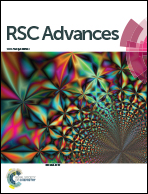Synthesis, structure elucidation and DFT studies of a new coumarin-derived Zn(ii) complex: in vitro DNA/HSA binding profile and pBR322 cleavage pathway†
Abstract
A new mononuclear zinc complex 1 bearing the bioactive coumarin scaffold 5,10-dioxo-5,10-dihydro-chromeno[5,4,3-cde]chromene-2,7-dicarboxylic acid was synthesized, characterized by elemental analysis and spectroscopic techniques, and further analyzed by single-crystal X-ray diffraction. Density functional theory studies were performed using an ab initio Gaussian 09 software package with a B3LYP/6-31+g(d,p) basis function. The in vitro DNA binding studies of complex 1 with calf-thymus DNA in Tris–HCl buffer was studied by various biophysical techniques, which revealed that 1 binds to calf-thymus DNA non-covalently via electrostatic interactions. Competitive binding experiments showed that 1 has the ability to displace DNA-bound ethidium bromide. Compound 1 exhibits efficient photoinduced DNA cleavage with supercoiled pBR322 involving the hydrolytic cleavage pathway due to the presence of coordinated water molecules. Such synthetic hydrolytic nucleases, in particular those that cleave DNA with sequence selectivity different from that of the natural enzymes, are gaining considerable attention owing to their importance in biotechnology and drug design.


 Please wait while we load your content...
Please wait while we load your content...